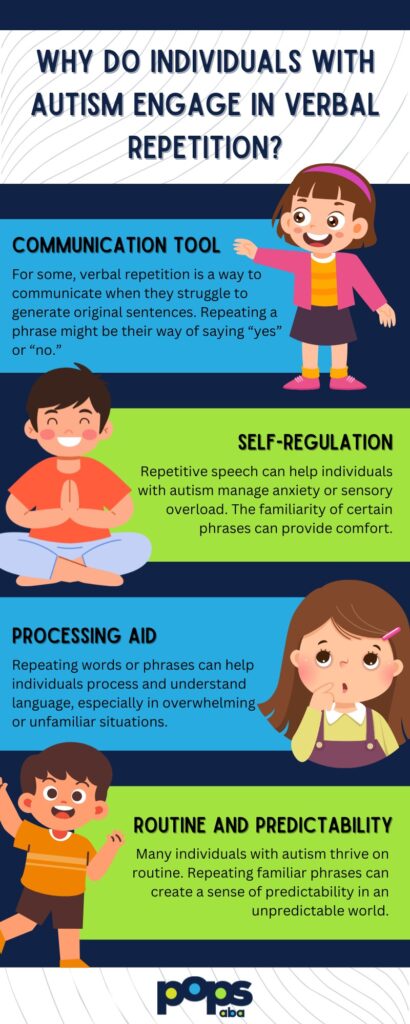Key Points:
- Verbal repetition and echolalia are common in individuals with autism, often serving as a communication tool or self-regulation mechanism.
- These behaviors can be immediate or delayed, with each type having distinct characteristics and purposes.
- Understanding the causes and functions of repetitive speech can help caregivers and therapists develop effective strategies to support communication development.
- Applied Behavior Analysis (ABA) therapy is a proven approach to address verbal repetition and echolalia in autism.
Hearing your child repeat the same phrase over and over? Verbal repetition in autism, or echolalia, is more than just mimicry—it’s often a tool for communication or coping. Discover what it means, why it happens, and how you can support your child’s unique way of expressing themselves.

What Is Verbal Repetition in Autism?
Verbal repetition in autism involves the repetition of words, phrases, or sounds, which can occur right after hearing them or at a later time. This behavior is typically divided into two main types: immediate echolalia and delayed echolalia.
Immediate echolalia happens when someone repeats what they’ve just heard. For example, if you ask, “Would you like some water?” they might echo back, “Would you like some water?” instead of giving a direct response. Delayed echolalia, however, involves repeating phrases or sentences heard earlier, such as lines from a favorite movie, TV show, or past conversations.
These repetitions are far from meaningless. They often serve important functions, such as facilitating communication, expressing desires, or helping the individual make sense of their surroundings. For example, a child might say, “Time to go home,” not because it’s actually time to leave, but to convey that they’re feeling uncomfortable or ready to leave a situation.
Why Do Individuals with Autism Engage in Verbal Repetition?
Understanding the causes of verbal repetition in autism requires looking at the underlying functions of these behaviors. While every individual is unique, research suggests several common reasons:

Strategies to Address Verbal Repetition and Echolalia
Addressing verbal repetition and echolalia in autism requires a thoughtful, individualized approach. These behaviors often serve specific purposes, so the goal isn’t to eliminate them but to build more flexible communication skills. Here are some effective strategies:
1. Model Functional Language
Instead of discouraging repetitive speech, model how to use the phrase in a functional way. For example, if a child repeats, “Do you want juice?” respond with, “Yes, I want juice,” to demonstrate appropriate usage. This helps them understand how to apply the phrase in context.
2. Use Visual Supports
Visual aids like picture cards, communication boards, or apps can provide alternative ways to express needs. These tools reduce reliance on echolalia by offering concrete, visual ways to communicate. For instance, a child can point to a picture of a drink instead of repeating a phrase.
3. Encourage Turn-Taking
Engage in activities that promote turn-taking, such as simple games or structured conversations. This practice helps individuals generate their own responses rather than relying on repetition. Start with short exchanges and gradually increase complexity.
4. Incorporate Interests
Use the individual’s interests to motivate communication. If they love a particular TV show, incorporate phrases or characters into learning activities. This makes communication more engaging and relevant to their world.
5. Create Predictable Routines
Many individuals with autism find comfort in routines. Establishing predictable communication patterns can reduce anxiety and the need for repetitive speech. For example, using consistent phrases during daily activities can provide a sense of stability.
6. Seek Professional Support
Working with a speech-language pathologist or ABA therapist can provide tailored strategies. These professionals can identify the function of verbal repetition and develop personalized interventions to foster more effective communication.
How ABA Therapy Can Help
Applied Behavior Analysis (ABA) therapy is one of the most effective approaches for addressing verbal repetition in autism. ABA focuses on understanding the purpose of behaviors and teaching new, more adaptive skills.
For example, an ABA therapist might work with a child to replace repetitive phrases with functional language. If a child repeatedly says, “It’s time to go,” the therapist might teach them to say, “I want to leave” or “I’m done” instead.
ABA therapy also emphasizes positive reinforcement, rewarding desired behaviors to encourage their use. Over time, this can help individuals with autism develop more flexible and effective communication skills.
Discover How Pops ABA Can Help Your Child Thrive
If your child exhibits verbal repetition in autism or other communication challenges, Pops ABA is here to help. Our team of experienced ABA therapists in New Jersey and North Carolina specializes in creating personalized intervention plans to address repetitive speech and foster meaningful communication.
At Pops ABA, we believe every child has the potential to thrive. Through evidence-based ABA therapy, we work closely with families to develop strategies that support communication, social skills, and independence.
Ready to take the next step? Contact Pops ABA today to schedule a consultation and learn how we can support your child’s unique needs. Let’s work together to unlock their full potential.



